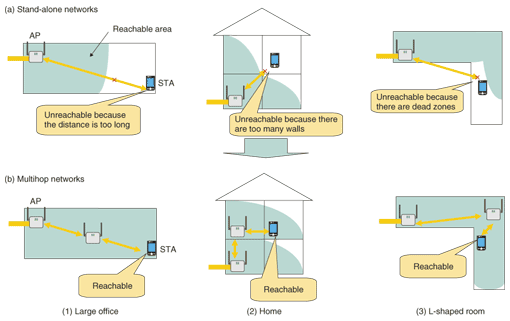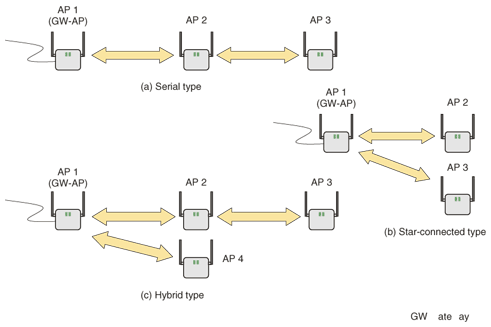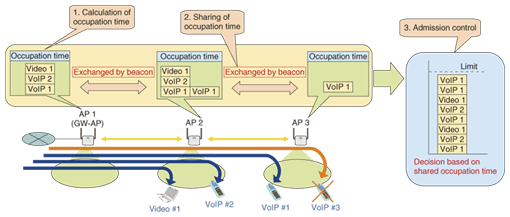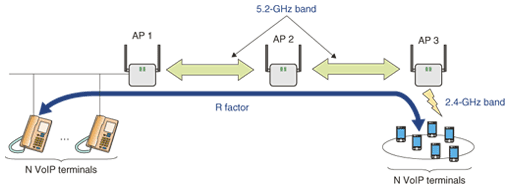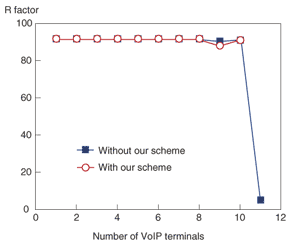 |
|||||||||
|
|
|||||||||
Vol. 5, No. 11, pp. 49–53, Nov. 2007. https://doi.org/10.53829/ntr200711sf8 Admission Control Scheme for Resources Shared by Access Points in Multihop WLANsAbstractWireless local area networks (WLANs) with multiple hops (multihop WLANs), which make it easy to extend WLAN areas, are being developed. This article introduces an admission control scheme for resources shared by access points that affect the quality of service of realtime services such as voice and video.
1. Multihop WLANsAlthough wireless local area network (WLAN) systems are now being used in many places, they face various problems. One of these problems is a lack of WLAN availability, which can occur for various reasons, as shown in Fig. 1(a). Services can be unavailable because the distance between the access point (AP) and station (STA) is too long, because there are too many walls between the AP and the STA, or because there are dead zones between the AP and STA even when they are not too far apart. Multihop WLANs have the potential to solve these problems. Their advantages are shown in Fig. 1(b). They can be used in places and circumstances where neither wired networks nor ordinary WLANs can be used, for example anywhere in the home, and they have fewer dead zones.
The three types of multihop WLANs are shown in Fig. 2. These are (a) the serial type, which may contain four or more APs, (b) the star-connected type, and (c) the hybrid of the serial and star-connected types.
2. Problems with multihop WLANsIn a multihop WLAN, only one AP (the gateway access point (GW-AP)) is connected to a wired network, as shown in Fig. 2. Therefore, all traffic to and from STAs associated with other APs travels over the links between the GW-AP and adjacent APs. Traffic in excess of the link°«s capacity degrades the quality of service (QoS) for realtime services even if traffic for each AP is lower than the AP°«s capacity. Therefore, we need an admission control scheme not only for wireless links between APs and STAs but also for ones between different APs in order to provide realtime services in multihop WLANs 3. Admission control scheme for wireless link resources between APsWe have developed an admission control scheme for multihop WLANs that solves the problem described above. It suppresses the degradation of QoS for realtime traffic caused by an increase in the number of STAs that have realtime traffic, and it maintains the QoS of realtime traffic over multihop WLANs. The configuration of the scheme is shown in Fig. 3. The scheme has three functions, which calculate the occupied time, share the occupation time among APs, and provide admission control. Figure 3 also shows that the channel between AP1 and AP2 is the same as that between AP2 and AP3. These three functions are described in sections 3.1—3.3.
3.1 Function for calculating occupation timeThis function calculates the occupation time, which is the time taken by the AP to transmit data to adjacent APs. 3.2 Function for sharing occupation timeThis function enables all APs that belong to the multihop network to share the calculated occupation time. Each AP sends beacon frames that include occupation time information. When other APs receive these beacon frames, they store them. Next, all APs send the occupation time information of all other APs when they send beacon frames. Through repetition of this operation, all APs learn the occupation time of all other APs even if one AP is so far from another AP that they cannot communicate with each other directly. 3.3 Admission control functionAn AP decides whether to permit a connection with an STA when the STA asks the AP for a connection. The AP refuses the connection with the STA if the sum of the stored occupation time and requested occupation time of the STA is larger than the allowable time. On the other hand, if the sum is smaller than or equal to the allowable time, the AP moves on to the next procedure, which is explained in the third article in this Special Feature, °»Admission and Traffic Control Techniques for WLANs°… [1]. The AP permits the connection from the STA if that procedure permits it. 4. Effect of our schemeAn example of the effect of our scheme, as measured by experiment, is shown in Fig. 4. In the experiment, three APs were connected in series, and test equipment simulating voice over IP (VoIP) terminals as STAs was connected to AP3. Test equipment simulating VoIP terminals was also connected to the wired network. Then, R-factors, which represent the quality of VoIP [2], were measured. In this experiment, the 2.4-GHz band was used for the wireless connection between an AP and STAs, and the 5-GHz band was used for the connection between APs. The channel between AP1 and AP2 was the same as the channel between AP2 and AP3. The transmission rate between APs was 6 Mbit/s.
The R-factors versus the number of STAs are shown in Fig. 5. Here, the red line represents the R-factors with our scheme and the blue line represents the conventional scheme without it. No red line is plotted in the area where the number of STAs was more than 10 because AP3 refused the connection from the 11th STA. Moreover, when there were ten or fewer STAs, the red line, i.e., our scheme, indicates that the R-factors were good. In other words, the QoS of VoIP was good. On the other hand, the blue line, i.e., the conventional scheme, shows that the QoS of VoIP degraded when there were more than 10 STAs. This is because the admission control scheme that did not account for resources between APs permitted the connection from the 11th STA even when there was a lack of resources between APs. These results show that the admission control scheme that took account of resources shared by APs worked well and maintained the QoS for VoIP.
5. ConclusionWe have developed an admission control scheme that takes account of resources shared by APs in multihop WLANs. This scheme can maintain the QoS for realtime services in multihop WLANs. In the future, we plan to study multihop networks that use higher-speed WLANs. References
|
|||||||||








